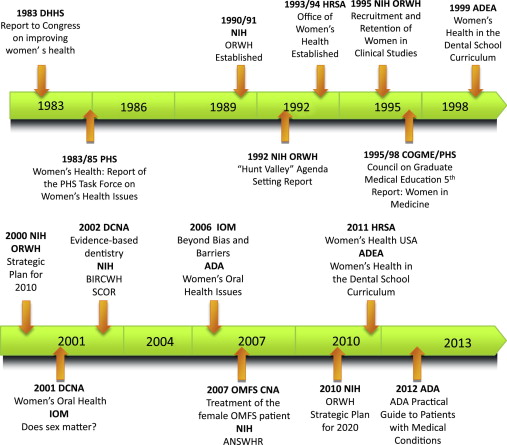Women’s health, including oral health, is an evolving science with foundation knowledge from many disciplines. Key milestones, particularly in the last decade, provide a roadmap towards the necessary inclusion of gender into dental practice. Such focus is especially important for the evolving role of oral health care providers as primary health care providers. Continued progress of the vibrant incorporation of evidence-based women’s oral health into the standard practice of oral health care is encouraged. This expanded preface provides an introduction to this DCNA issue, a brief history and timeline of major women’s oral health events, and resources for further consideration.


“Another issue on women’s health?” you might ask. You are right; Dental Clinics of North America ( DCNA ) has previously provided the platform for dissemination of information on women and oral health. “Has much changed?” you might further ask. It has been more than a decade since the full issue “Women’s Oral Health” in July 2001, and in that time, yes, a lot has changed.
Certainly our understanding of women’s health has changed, but there has been an even deeper change in our expectations as clinicians. These days, we clinicians demand increased depth and veracity of the information forming the foundations from which we work, for making our decisions evidence based. Not only have our expectations changed, the contexts in which we are working have changed. As we further integrate into comprehensive health care for our patients, it behooves us to be on a level playing field with our other health care colleagues. Also, we anticipate that our patients and communities have different expectations of us.
The question “Does sex matter?” has been discussed for years. The Institute of Medicine (IOM) report entitled Exploring the Biologic Contributions to Human Health: Does Sex Matter? , like the DCNA on women’s oral health, was published in 2001. Its preface concludes: “Sex does matter. It matters in ways we did not expect. And it matters in ways we have not yet begun to imagine.”
A decade ago, the previous DCNA on women’s health drew attention to the complex interrelationships among sex, gender, and systemic and oral health. The issue moved dentistry into the “emerging field of women’s health,” recognizing the need and value of “gender-specific evaluation and treatment considerations for dental patients who are women.”
This introduction provides a brief history, and encourages continued progress on the vibrant incorporation of evidence-based women’s oral health into the standard practice of oral health care. It includes a review of the definitions of sex, gender, and evidence-based dentistry; a timeline of major women’s oral health events; and resources for further research and curricular development.
Sex and gender
A recently published article by Springer and colleagues provides insight into the complexities of defining sex and gender. Sex is not a clearly dichotomous variable (male/female) that is solely a function of hormones and anatomy. Instead, social and environmental influences (gender) are inextricably interwoven with biologic ones whenever sex-related health issues are considered. Biology has an impact on gender, but environmental factors in turn have an impact on biology. In short, sex and gender are entangled concepts and not separate domains.
In 2011, the IOM held a workshop that led to the report “Sex-specific Reporting of Scientific Research: A Workshop Summary.” This report suggested that issues of sex/gender need to be included more often in scientific publications. Suggestions included identifying the sex of the individuals in journal populations, sharing of sex-identified raw data, giving extra credit in reviews of articles that include sex-specific information, and requiring sex-stratified analysis where applicable.”
A dental perspective on these nuances can be seen in an article published in the United Kingdom. Doyal and Naidoo discuss the experience of pain and the causation of dental caries as examples of where sex and gender interact.
Evidence-based oral health
Medicine and dentistry have recently embraced evidence-based clinical decisions to optimize oral health outcomes for their patient populations. Individual decisions incorporate the best available scientific evidence, the clinician’s expertise, and the patient’s health care needs and personal preferences. A previous volume of the DCNA was dedicated to evidence-based dentistry (EBD).
Although most agree that it is good to apply current scientific evidence to clinical decision making, the translation of research into health care practice usually lags by several years. Barriers to EBD include lack of time, obstacles to accessing studies, lack of understanding the significance of results, and lack of user-friendly resources.
Strategies to identify the best available scientific evidence for treatment decisions include using evidence-based guidelines, systematic reviews, and accessing the primary scientific literature. Box 1 contains examples of resources for online information on EBD.
| Resource | Web Site Address |
|---|---|
| American Dental Association EBD Web site | http://ebd.ada.org |
| Searchable database of systematic reviews in oral health | http://ebd.ada.org/SystematicReviews.aspx |
| PubMed | http://www.ncbi.nlm.nih.gov/pubmed/ |
| Cochrane Oral Health Group | http://ohg.cochrane.org |
| TRIP | http://www.tripdatabase.com/ |
| American Congress of Obstetricians and Gynecologists | www.acog.org |
| American Medical Association | http://www.ama-assn.org/ |
| National Guideline Clearinghouse | http://guideline.gov |
The American Dental Association (ADA) is a leader in EBD, but the evidence base for women’s oral health care is still evolving. Box 2 gives brief examples of topics related to women’s oral health captured in the ADA database on systematic reviews. “Women’s Health” is an article in the 2012 The ADA Practical Guide to Patients with Medical Conditions . Perhaps a wider perspective of women’s health is warranted given the broadening view by medicine and health research.
| General Areas | Example Topics |
|---|---|
| Pregnancy | Smoking cessation Oral health during pregnancy Periodontal disease and adverse pregnancy outcomes Prenatal cleft lip and palate detection |
| Bone dynamics | Bisphosphonates/osteonecrosis of the jaw Osteoporosis and bone mineral density Gender effects on unilateral condylar hyperplasia Sex differences in periodontal disease Sex differences in temporomandibular disorders |
| Cardiovascular disease | Cleft palate and risk of cardiovascular events CVD and osteoporosis among women with physical disability |
| Other topics | Oral and perioral piercings Oral human papillomavirus infection Menopause and oral health Human immunodeficiency virus–related oral disease among women |
Evidence-based oral health
Medicine and dentistry have recently embraced evidence-based clinical decisions to optimize oral health outcomes for their patient populations. Individual decisions incorporate the best available scientific evidence, the clinician’s expertise, and the patient’s health care needs and personal preferences. A previous volume of the DCNA was dedicated to evidence-based dentistry (EBD).
Although most agree that it is good to apply current scientific evidence to clinical decision making, the translation of research into health care practice usually lags by several years. Barriers to EBD include lack of time, obstacles to accessing studies, lack of understanding the significance of results, and lack of user-friendly resources.
Strategies to identify the best available scientific evidence for treatment decisions include using evidence-based guidelines, systematic reviews, and accessing the primary scientific literature. Box 1 contains examples of resources for online information on EBD.
| Resource | Web Site Address |
|---|---|
| American Dental Association EBD Web site | http://ebd.ada.org |
| Searchable database of systematic reviews in oral health | http://ebd.ada.org/SystematicReviews.aspx |
| PubMed | http://www.ncbi.nlm.nih.gov/pubmed/ |
| Cochrane Oral Health Group | http://ohg.cochrane.org |
| TRIP | http://www.tripdatabase.com/ |
| American Congress of Obstetricians and Gynecologists | www.acog.org |
| American Medical Association | http://www.ama-assn.org/ |
| National Guideline Clearinghouse | http://guideline.gov |
The American Dental Association (ADA) is a leader in EBD, but the evidence base for women’s oral health care is still evolving. Box 2 gives brief examples of topics related to women’s oral health captured in the ADA database on systematic reviews. “Women’s Health” is an article in the 2012 The ADA Practical Guide to Patients with Medical Conditions . Perhaps a wider perspective of women’s health is warranted given the broadening view by medicine and health research.
| General Areas | Example Topics |
|---|---|
| Pregnancy | Smoking cessation Oral health during pregnancy Periodontal disease and adverse pregnancy outcomes Prenatal cleft lip and palate detection |
| Bone dynamics | Bisphosphonates/osteonecrosis of the jaw Osteoporosis and bone mineral density Gender effects on unilateral condylar hyperplasia Sex differences in periodontal disease Sex differences in temporomandibular disorders |
| Cardiovascular disease | Cleft palate and risk of cardiovascular events CVD and osteoporosis among women with physical disability |
| Other topics | Oral and perioral piercings Oral human papillomavirus infection Menopause and oral health Human immunodeficiency virus–related oral disease among women |
An overview of milestones
The timeline ( Fig. 1 ) on women’s oral health in the United States formally starts only 30 years ago (1983), when the Department of Health and Human Services (DHHS) Coordinating Committee on Women’s Health provided a report to Congress seeking improvement of women’s health in the United States. Great progress has subsequently occurred. The work shows how challenging the consideration of sex and gender continues to be.

From a bird’s-eye view, the major US players in the timeline (see Fig. 1 ) who have promoted research and clinical practice on women’s oral health are the National Institutes of Health (NIH), particularly the Office of Research on Women’s Health (ORWH) and the National Institute of Dental and Craniofacial Research (NIDCR); Health Resources and Services Administration (HRSA); IOM; ADA; and the American Dental Education Association (ADEA).
NIH/ORWH
For a health condition to be considered as a women’s issue, it should be unique, more prevalent, or more serious among women than among men, or it should have risk factors or interventions that are different for women. These criteria were defined in the 1985 report “Women’s Health: Report of the Public Health Service Task Force on Women’s Health Issues,” chaired by Dr Ruth Kirschstein. It provides the foundation for contemporary thinking, policies, and programs involving women’s health and sex/gender differences research.
The NIH/ORWH was established in 1990 as part of a congressional mandate to include women as subjects and investigators in scientific research. Its agenda-setting 1993 report, Report of the National Institutes of Health: Opportunities for Research on Women’s Health (known as the Hunt Valley report) included broad public participation in the process of priority setting. This model has been used subsequently for both professional and public commentary regarding women’s health issues and women’s health research.
An extensive national effort that included researchers, scientists and other stakeholders resulted in the Agenda for Research on Women’s Health for the 21st Century . This document boosted the collaborative multidisciplinary research efforts of the NIH/ORWH with regard to women’s health research.
The most recent strategic plan from the NIH/ORWH was developed through town hall meetings held around the country between March 2009 and February 2010. Moving Into the Future with New Dimensions and Strategies: A Vision for 2020 for Women’s Health Research aims to increase understanding of major diseases and conditions that disproportionately affect the overall quality of life for women. Both women and men should benefit from the increased understanding of sex/gender in disease risk, vulnerability, progression, and outcomes.
Oral Health Strategic Plan Component of the ORWH
In September 2009, the Working Group on Oral Health and Systemic Conditions was convened under the direction of the NIH/ORWH. Its goals were to identify gaps in the current knowledge, the specific impact of oral health on women’s health, and future research needs. It made 12 recommendations of topics for future research areas and specific research activities. Box 3 lists the basic recommendations.



